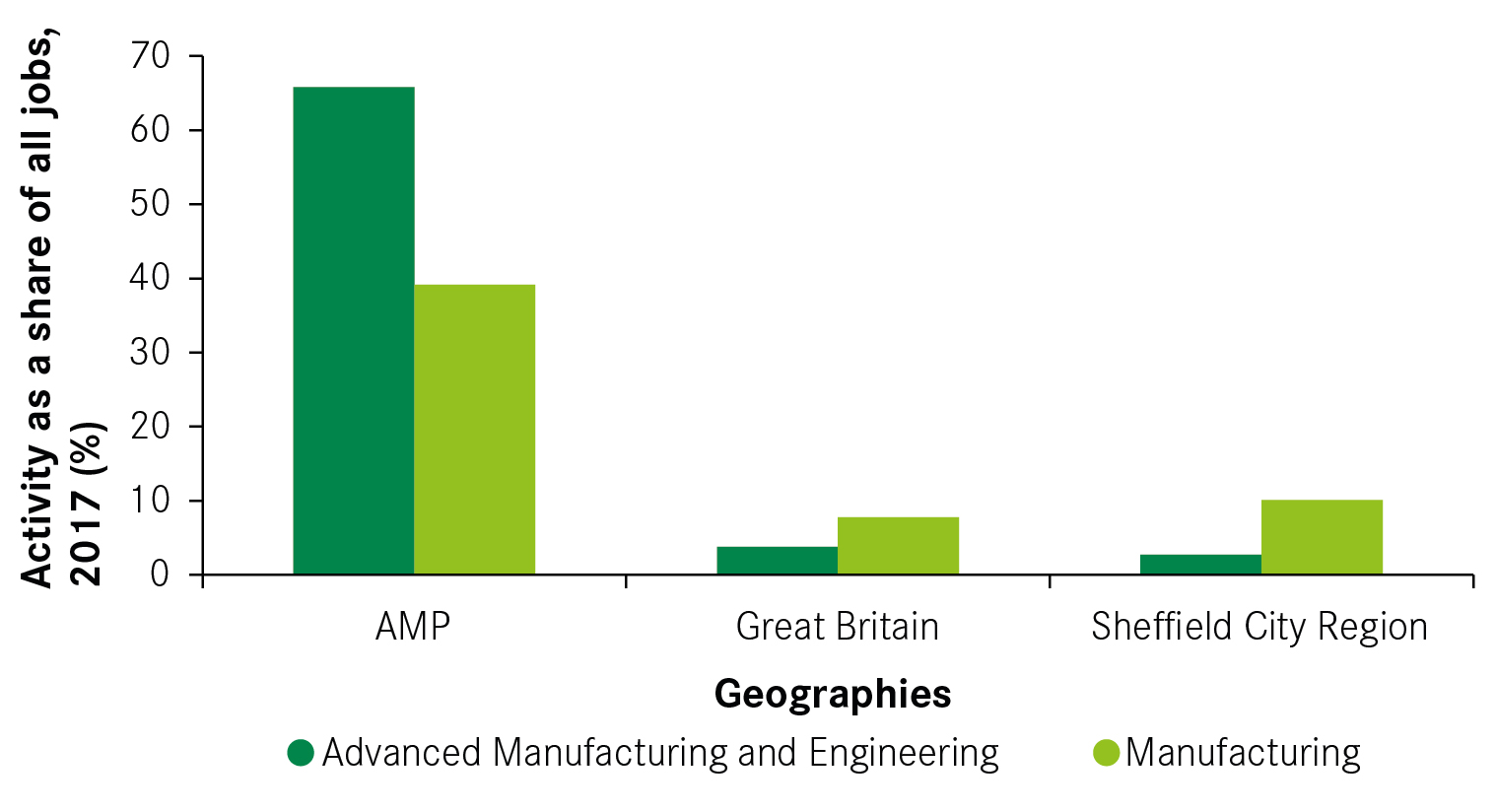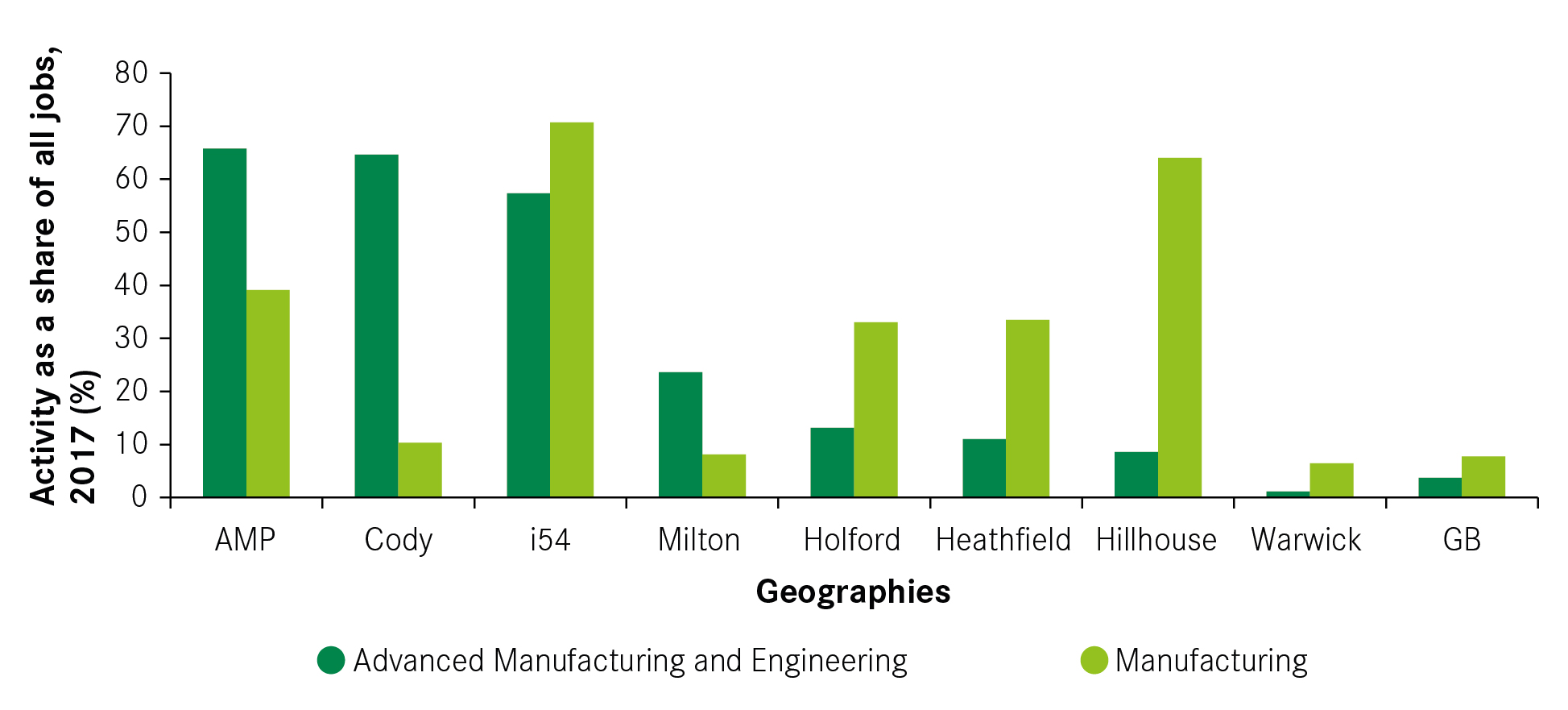03The performance of the AMP in Sheffield City Region and beyond
Addressing Sheffield City Region’s productivity problems, therefore, means not just improving the productivity of existing activity in Sheffield, but also ensuring that new and higher-skilled exporting work is created in and attracted to the city-region.
The University of Sheffield’s Advanced Manufacturing Research Centre (AMRC) and the Advanced Manufacturing Park (AMP) in which the core of the AMRC is based is part of the response to this issue.
Box 2: What are the AMP and AMRC?
The University of Sheffield’s AMRC and the AMP are distinct. The AMRC is a University-owned industrial research institution that links together advanced manufacturing research expertise in the University of Sheffield with multinational supply-chain manufacturing companies both in Sheffield and outside it.
The AMRC is a Catapult facility with projects across a range of areas including aerospace, automotive, civil nuclear energy, and health and is primarily located on the AMP. The AMP is located in Rotherham, close to the boundary with Sheffield.
The AMRC provides small amounts of commercial space for companies and manufacturing and access to industry-leading research equipment for experimental production runs. Companies that decide they want a more involved relationship to the AMRC’s benefits can locate on the AMP in facilities of their own, or they can remain elsewhere and tap into the wider network when they wish.
The AMRC includes specialist spaces such as the Nuclear AMRC, the Medical AMRC, and Factory 2050, with industry collaboration based in Sheffield. The AMRC is part of a network with activities elsewhere in the country, including at the Airbus wing-manufacturing facility in Wales.
In contrast to the Sheffield City Region as a whole, the AMP is a cluster of advanced manufacturing jobs. Figure 5 shows that 66 per cent of all jobs in the park are in advanced manufacturing. This is compared to 4 per cent in the UK as a whole, and 3 per cent across the Sheffield City Region.
As Figure 2 shows, this advanced manufacturing is especially productive work compared to the rest of Sheffield City Region’s economy.
The AMP also outperforms in its appeal to advanced manufacturing and engineering compared to other similar parks around the country. Figure 6 shows that the AMP has the highest share of advanced manufacturing jobs compared to similar industrial estates in other parts of the country.
Box 3: Comparing the AMP to other parks
A number of similar initiatives such as the International Advanced Manufacturing Park in Sunderland; the Advanced Manufacturing Innovation District Scotland in Glasgow; and the Teesside Advanced Manufacturing Park are not yet in operation and therefore cannot be evaluated.
To compare the performance of the AMP to other places, a number of employment sites similar to the AMP were identified that were small enough to be distinct areas of advanced economic activity but large enough not to be dominated by one single manufacturing employer.
These include i54 in Wolverhampton/South Staffordshire, Cody Technology Park in Aldershot, Milton Park in Oxfordshire, Holford in Birmingham, Hillhouse near Blackpool, which is part of Lancashire Energy Enterprise Zone, Heathfield Industrial Estate in Exeter, and Warwick Technology Park.
Despite being associated with advanced manufacturing or manufacturing parks, several of the parks do not seem to be particular concentrations of either activity. Milton Park in Oxfordshire has a small share of advanced manufacturing. Warwick Technology Park has very few advanced manufacturing or manufacturing jobs as a share of total employment – and has a much greater share of jobs in programming, consulting, or head office activities.
In terms of advanced manufacturing, Cody Technology Park in Aldershot is the most similar to the AMP – it has a strong aerospace and defence presence, but unlike the AMP, little on-site manufacturing.
The AMP is a small part of Sheffield City Region’s economy
In terms of employment, the impact on Sheffield City Region’s economy is modest. Only 499 private sector advanced manufacturing jobs are on the site, a small share of the Sheffield City Region’s overall advanced manufacturing employment of 15,659. The AMP accounts for only 3 per cent of all the Sheffield City Region’s advanced manufacturing and engineering jobs.
This is not unusual – many of the comparator parks also play small roles in their local economies. Cody for example only contains 3 per cent of Hampshire and the Isle of Wight’s advanced manufacturing and engineering jobs.
The AMP is small, however, compared to the other business parks. Figure 7 shows that the AMP employs fewer people than any of the comparator areas. Milton Park employs more than 8,000 people, including more than 2,000 advanced manufacturing jobs. Cody and Milton Park, for instance, have a lower concentration of advanced manufacturing activity than the AMP as a share of work on the site, but a larger total number of advanced manufacturing jobs.
The AMP is an attractive location within Sheffield City Region’s economy
There is high demand from firms to locate on the AMP and this can be seen in the evidence on jobs and land values.
Most of the jobs on the AMP are new. Figure 8 indicates that over half of the jobs currently on the site have been created since 2012, rather than being already present or simply displaced from a different prior location. This is much higher than for any of the other comparator parks.
And these jobs have been created by firms which locate on the AMP even though it is expensive to do so. Figure 9 shows that the price of land on the AMP is high compared to Sheffield City Region as a whole.
The price of industrial land on the AMP is at a rateable value of £59 per sqm, much higher than in the rest of Sheffield City Region (£38) and the average for England (£44). The value of industrial land on the AMP is comparable to Cody, Milton Park and Warwick in affluent areas of England, and higher than the other comparators in Birmingham, Exeter, and Fleetwood.
This suggests the AMP is a high demand area compared to other advanced manufacturing parks. The AMP’s land is as, or more, valuable than these other parks, despite being in a city-region with a much weaker skills base. Figure 10 shows that Sheffield City Region has fewer workers occupying a high-level position (such as managers, engineers, data scientists or lawyers) than any of the regions in which the comparator business parks are located.
There is a large gap between Sheffield City Region and the regions of Cody and Milton parks (Hampshire and Berkshire, Buckinghamshire and Oxfordshire) with the most expensive land. Here, high-level occupations account for 42 and 48 per cent of all jobs, compared to 35 per cent in Sheffield City Region. Advanced manufacturing locates in these other parks in part due to the skills their local economies can offer. This drives up local wages and the price of land.
But, although skills levels in the Sheffield City Region are weaker than in any of the other areas, they are likely to be much higher on the AMP. As mentioned, 66 per cent of all jobs on the AMP are in advanced manufacturing, and on average 64 per cent of all advanced manufacturing jobs nationally are estimated to be high-level occupations.8 This divide between the AMP and the rest of Sheffield City Region indicates that the AMP is able to offer benefits to high-value manufacturing activity that the rest of the Sheffield City Region struggles to provide.
Summary
The AMP is a cluster of high-skilled and productive activity. Even though the AMP is expensive to locate on, there are now almost 500 advanced manufacturing jobs on the site, with half of all jobs having been created since 2012.
Understanding what these results mean for national and local industrial strategy requires an understanding of the origins of the AMP, its appeal to firms, and whether the model is replicable in other places.






